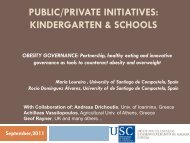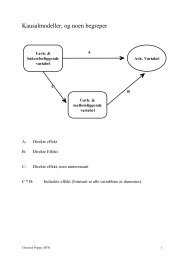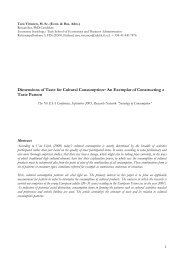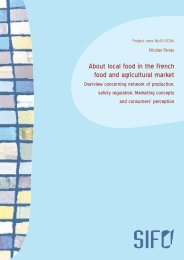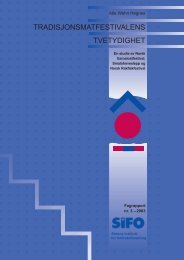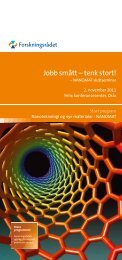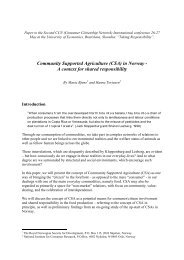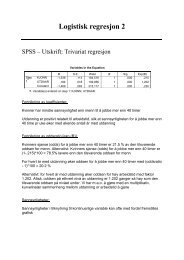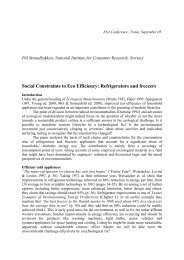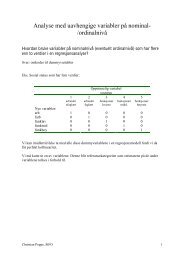an investigation of domestic laundry in europe - habits ... - SIFO
an investigation of domestic laundry in europe - habits ... - SIFO
an investigation of domestic laundry in europe - habits ... - SIFO
Create successful ePaper yourself
Turn your PDF publications into a flip-book with our unique Google optimized e-Paper software.
96An <strong><strong>in</strong>vestigation</strong> <strong>in</strong>to the <strong>domestic</strong> <strong>laundry</strong> <strong>habits</strong> <strong>in</strong> Europe4.5.1 RepeatabilityIf the samples are treated <strong>in</strong> a similar way <strong>in</strong> a series <strong>of</strong> <strong>in</strong>dependent tests, willthey yield the same results? The repeatability <strong>of</strong> the test<strong>in</strong>g method is evaluatedus<strong>in</strong>g two <strong>laundry</strong> samples, a dishcloth <strong>an</strong>d a diaper, <strong>an</strong>d a sterile sample<strong>in</strong> a 40°C cotton programme. These <strong>laundry</strong> samples are chosen because <strong>of</strong>their relatively high numbers <strong>of</strong> CFU <strong>in</strong> previous tests. The samples are onlytested for the Total Plate Count, Enterobacteriaceae <strong>an</strong>d Bacilli.The test is repeated five times <strong>in</strong> two identical household wash<strong>in</strong>g mach<strong>in</strong>es(Miele Novotronic W362). The dishcloth <strong>an</strong>d diaper were sampled accord<strong>in</strong>gthe method described <strong>in</strong> 4.4. One sample <strong>of</strong> the dishcloth, one sample <strong>of</strong> thediaper <strong>an</strong>d a sterile sample were washed <strong>in</strong> each was cycle with 3.3kg gammasterilised <strong>laundry</strong> at 40°C. twelve <strong>an</strong>d one-half ml defibr<strong>in</strong>ated sheep blood(Biotrad<strong>in</strong>g) was added per kg <strong>laundry</strong> to <strong>in</strong>crease the soil level. The waterhardness was 9°dH <strong>an</strong>d 52g Ariel Color (compact detergent without bleach<strong>in</strong>gagents) was added <strong>in</strong>to the dispenser. The samples were collected <strong>an</strong>d the micro-org<strong>an</strong>ismswere enumerated after wash<strong>in</strong>g. The results are presented <strong>in</strong>table 4-6 The Petri dish from one <strong>of</strong> the sterile samples (run 5) was contam<strong>in</strong>ated;thus, the logarithmic count is not available. The other logarithmiccounts are very much <strong>in</strong> l<strong>in</strong>e with each other. The maximum difference betweenthe runs is about 1 log unit.Table 4-5 Results <strong>of</strong> the repetitions <strong>of</strong> the test method at 40°C [logarithmic count <strong>of</strong> CFU<strong>in</strong> 4.7 cm2 sample]run 1 run 2 run 3 run 4 run 5Total Plate CountDiaper 4.2 3.9 4.6 3.9 4.0Dishcloth 6.4 6.0 6.1 5.7 5.6Sterile sample 4.1 4.0 4.2 4.2 3.9EnterobacteriaceaeDiaper 2.8 2.5 3.3 2.6 2.9Dishcloth 4.3 3.8 4.0 3.8 4.3Sterile sample 2.7 2.6 2.6 2.0 2.8BacillusDiaper 4.1 3.8 4.4 3.6 3.9Dishcloth 2.4 1.3 1.9 1.5 1.6Sterile sample 3.7 3.6 3.7 2.5 n/aStatistic <strong>an</strong>alysis did not show <strong>an</strong>y signific<strong>an</strong>t differences between the fiveruns (ANOVA-One Way, α = 0.05). Therefore, the method seems to be repeatable.



